MERCIFUL MARY IN THE BIBLE
Merciful Mary in the Bible, the mother of Jesus, holds a pivotal place in Christianity. celebrated for her faith and obedience. According to the New Testament, she was a young woman from Nazareth who received the angel Gabriel’s announcement that she would conceive Jesus through the Holy Spirit (Luke 1:26-38).
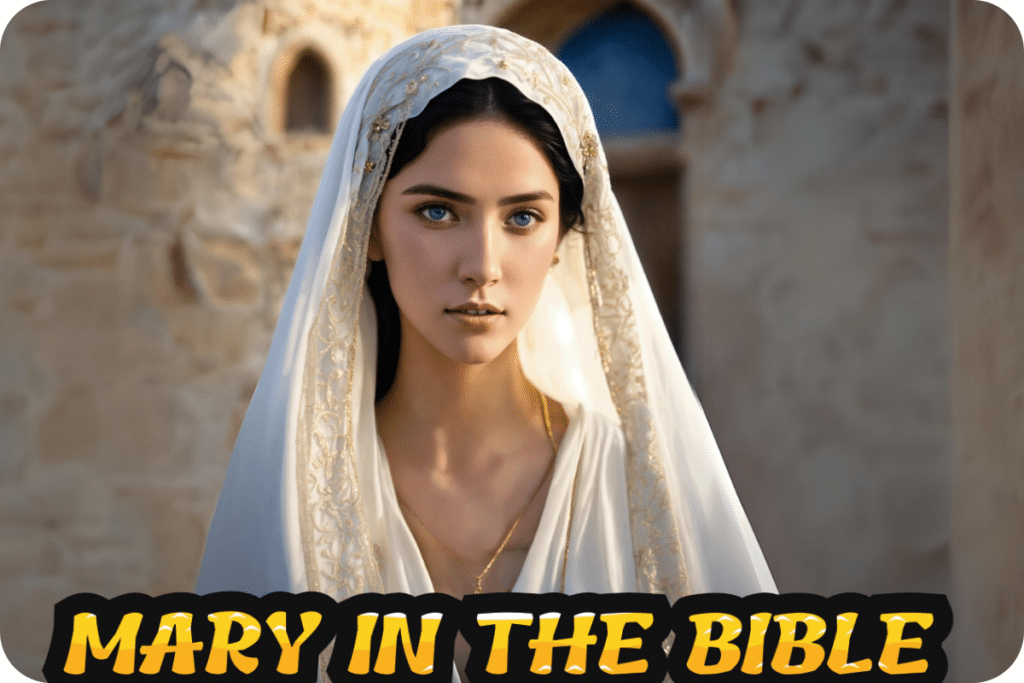
Mary in the Bible is often depicted as a devoted mother, present at key moments in Jesus’s life, including his crucifixion. Her role extends beyond motherhood; she is venerated as the “Mother of God” and a model of faith in various Christian traditions. The doctrines surrounding her, such as the Immaculate Conception and Assumption, highlight her significance in Christian theology.
Early Life of Mary in the Bible
Ancestry and Birth
Mary’s lineage is traditionally traced to the tribe of Judah, connecting her to King David. While the Bible provides limited details about her early life, apocryphal texts and church tradition suggest she was born to Anne and Joachim.
The genealogies in the Gospels of Matthew and Luke primarily focus on Joseph, but many theologians argue that Luke’s account reflects Mary’s lineage, indicating her descent from David through her father, Heli. Although Mary is related to Elizabeth, a Levite, tribal affiliation was determined by paternal lineage, affirming Mary’s Judean heritage and Jesus’s rightful claim to the Davidic throne.
Mary’s Family Background
According to tradition, Mary was born to Joachim and Anne, a pious Jewish couple who had long prayed for a child. When an angel announced that Anne would conceive, they rejoiced at Mary’s birth and dedicated her to God’s service at the temple when she was three years old.
Mary’s upbringing in a deeply religious household shaped her strong faith and willingness to accept God’s plan, as evidenced by her “yes” to the angel Gabriel. Though not mentioned in the Bible, the story of Joachim and Anne highlights the importance of family in shaping Mary’s character and her pivotal role in salvation history.
The Annunciation
The Angel Gabriel’s Visit
The Annunciation marks a pivotal moment in Christianity, when the angel Gabriel appeared to Mary in Nazareth and announced that she would conceive Jesus through the Holy Spirit (Luke 1:26-38). Mary’s acceptance of God’s will, despite her initial perplexity, is seen as an act of faith and obedience.
The Annunciation is a cornerstone of Christian theology, linking divine action with human history and demonstrating God’s love and grace. It is commemorated with prayers, special services, and traditions like the Angelus prayer across various Christian denominations.
Mary’s Acceptance
Mary’s response to the angel Gabriel during the Annunciation exemplifies her profound humility and faith. Initially troubled by the divine message, she ultimately embraced her role as God’s servant, stating, “I am the Lord’s servant. May your word to me be fulfilled” (Luke 1:38).

This declaration reflects her unwavering trust in God’s plan despite the uncertainties and potential societal repercussions she faced as an unwed mother. Mary’s acceptance is a powerful testament to her obedience and willingness to cooperate with divine will, serving as an enduring model of faith for Christians throughout the ages.
The Significance of the Annunciation
The Annunciation marks the moment when the angel Gabriel announced to Mary that she would conceive Jesus through the Holy Spirit, initiating the Incarnation (Luke 1:26-38). This event underscores God’s direct involvement in human history and Mary’s pivotal role in the divine plan of salvation.
By accepting God’s will with faith, Mary cooperated in the Incarnation and the redemption of humanity. The Annunciation is a cornerstone of Christian theology, linking divine action with human history and demonstrating God’s love and grace.
Mary and Joseph
Their Betrothal
In first-century Jewish culture, Mary and Joseph were betrothed, a formal agreement that was legally binding and often lasted about a year before the actual marriage ceremony. During this period, they were considered husband and wife, though they did not yet live together or consummate the marriage.
Joseph’s lineage from the house of David was significant, as it connected Mary and Jesus to the Davidic covenant and the Messiah’s promised throne. Their betrothal highlights the cultural and religious context of their time, where marriages were arranged by families and children did not choose their own spouses. The betrothal period allowed the couple to prepare for their life together before establishing their own household.
Joseph’s Role and Response
Joseph’s initial reaction to Mary’s pregnancy was one of concern and confusion, leading him to consider quietly divorcing her to avoid public shame (Matthew 1:19). However, an angel appeared to him in a dream, reassuring him that Mary’s conception was by the Holy Spirit and that he should take her as his wife (Matthew 1:20-21).
Joseph’s acceptance of this divine message and his subsequent protection of Mary and Jesus reflect his faith and righteousness, demonstrating his commitment to God’s plan despite the personal and societal challenges he faced.
Journey to Bethlehem
The journey to Bethlehem, prompted by a Roman census, fulfilled the prophecy of the Messiah’s birth in the city of David (Micah 5:2). Joseph and Mary traveled approximately 90 miles from Nazareth to Bethlehem, facing significant hardships, especially given Mary’s advanced pregnancy. Upon arrival, they found no lodging available, leading to Jesus’s humble birth in a manger (Luke 2:1-7).
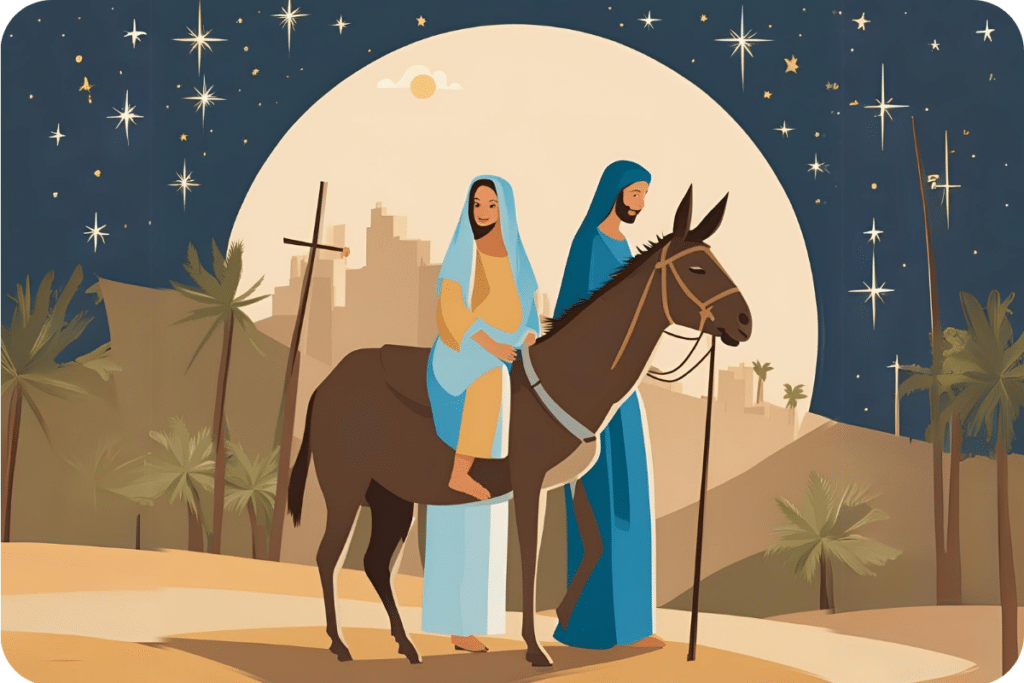
This event underscores the divine orchestration of circumstances, highlighting the significance of Jesus’s birth in a lowly setting, reflecting themes of humility and accessibility in the Christian faith.
The Birth of Jesus
The Nativity Story
The birth of Jesus is a cornerstone of Christian belief, symbolizing humility and divine love. Born in a stable and laid in a manger, Jesus’s entrance into the world reflects his identification with the lowly and marginalized. Shepherds, deemed outcasts, were the first to receive the announcement of his birth, emphasizing that salvation is accessible to all.
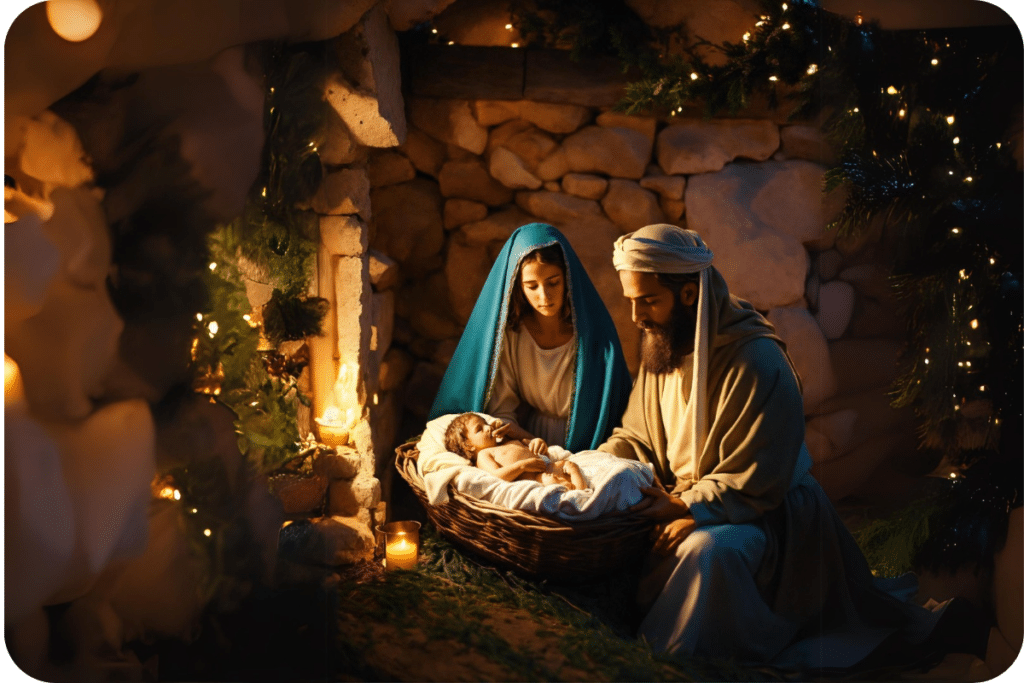
This nativity story, celebrated during Christmas, highlights the contrast between Jesus’s humble beginnings and his divine identity, showcasing God’s profound love for humanity through the incarnation.
Visitors to the Manger
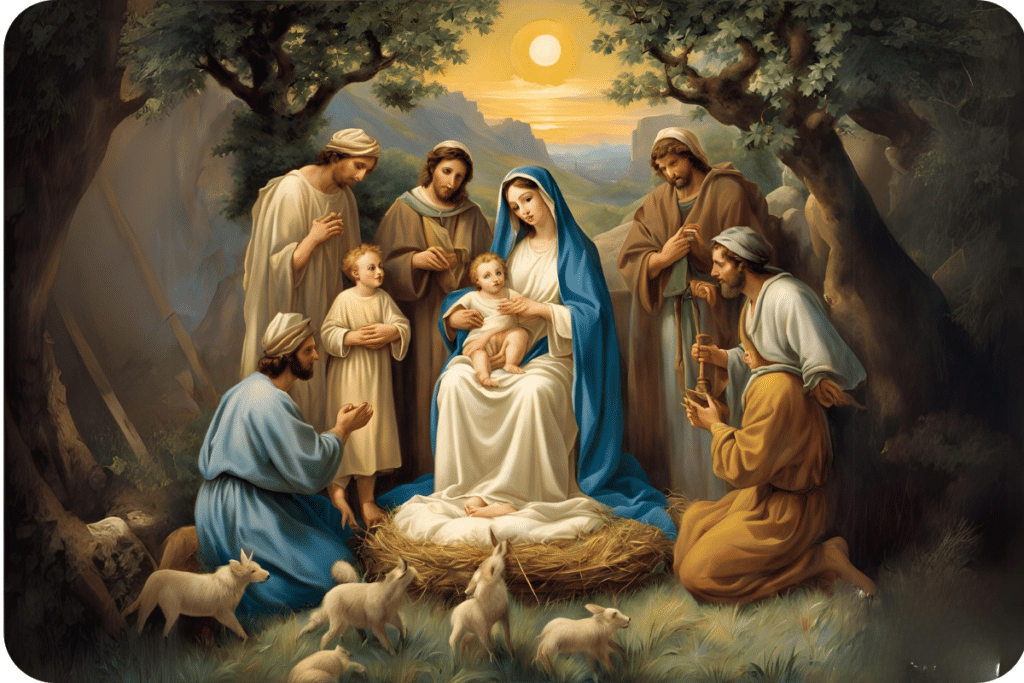
The visits of shepherds and wise men to honor the newborn Jesus highlight the universal significance of his birth. Shepherds, considered lowly in society, were the first to receive the angelic announcement, symbolizing God’s grace reaching the humble (Luke 2:8-20).
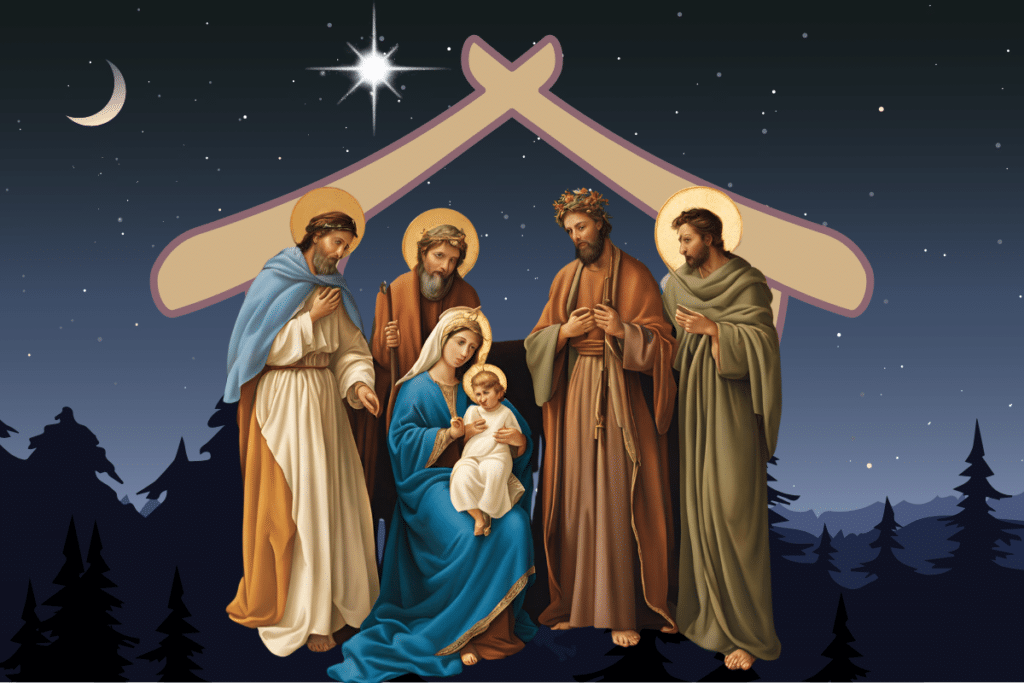
In contrast, the wise men, or Magi, came from the East, guided by a star, representing learned individuals seeking truth (Matthew 2:1-12). Their diverse backgrounds emphasize that Jesus’s message and salvation are for all people, regardless of social status or wisdom, reinforcing the inclusive nature of his divine mission.
Mary’s Role in Jesus’s Early Life
Presentation at the Temple
Following Jewish custom, Mary and Joseph presented Jesus at the Temple forty days after his birth, fulfilling the law of purification and the consecration of their firstborn (Luke 2:22-24). During this event, Simeon, a righteous man, recognized Jesus as the Messiah and prophesied about his future mission, stating he would bring salvation to all people (Luke 2:30-32).
Anna, a prophetess, also acknowledged Jesus, emphasizing his significance in the redemption of Jerusalem. This presentation underscores both Jesus’s divine purpose and Mary’s vital role in his life and mission.
Flight to Egypt
Warned by an angel, Mary and Joseph fled to Egypt to escape King Herod’s decree to kill Jesus (Matthew 2:13-15). This urgent journey ensured Jesus’s safety and fulfilled the prophecy from Hosea, “Out of Egypt I called my son” (Hosea 11:1).
By seeking refuge in Egypt, the Holy Family mirrored Israel’s exodus, emphasizing Jesus’s identity as the Messiah and God’s protective plan. Their flight illustrates the fulfillment of divine prophecy and the lengths to which God went to safeguard the infant Jesus, highlighting the significance of his mission.
Return to Nazareth
After fleeing to Egypt to escape King Herod, Mary and Joseph returned to Nazareth, where Jesus grew up. During these formative years, Mary’s nurturing role was vital as she cared for and guided her son. She taught him the traditions and values of their faith, instilling a strong spiritual foundation.
Mary’s attentiveness and love shaped Jesus’s early life, providing a stable environment that allowed him to grow in wisdom and favor with God and man, reflecting her dedication as a mother.
Mary at the Wedding at Cana
The First Miracle
At the wedding in Cana, Mary intervened when the wine ran out, asking Jesus to help (John 2:1-11). Her faith in her son’s abilities and her intercession led to Jesus performing his first public miracle, turning water into wine.
This event demonstrates Mary’s influence and belief in Jesus’s divine mission. Her words to the servants, “Do whatever he tells you,” reflect her trust in Jesus and her desire to help others encounter him. Mary’s role at Cana foreshadows her ongoing role as an intercessor, leading people to her son.
Mary’s Influence on Jesus’s Ministry
At the wedding at Cana, Mary exemplified her supportive role in Jesus’s ministry by interceding when the wine ran out, prompting him to perform his first miracle (John 2:1-11). Her request and faith in his abilities highlight her influence and belief in his divine mission. By instructing the servants to “do whatever he tells you,” Mary not only guided them but also demonstrated her trust in Jesus’s authority.
This event underscores the importance of maternal influence and faith, showcasing how Mary actively participated in the unfolding of Jesus’s ministry and the joy it brings to others.
Mary During Jesus’s Ministry
Mary and Jesus’s Siblings
During Jesus’s ministry, Mary likely remained in Nazareth caring for her other children and supporting Jesus’s mission from afar. The Gospels mention Jesus’s brothers and sisters, indicating he had siblings.
Mary’s role shifted from being physically present to one of prayer and spiritual support as Jesus traveled and preached. Though not always physically with him, Mary’s faith and obedience continued to shape Jesus’s life and ministry. Her example of humble trust in God’s plan served as a model for the early Church.
Mary’s Presence at Key Events
Mary’s presence at various events during Jesus’s ministry illustrates her steadfast support and deep connection to his work and message. She witnessed his teachings and miracles, including the wedding at Cana, where her faith prompted his first miracle.
Her involvement signifies not only her maternal influence but also her active role in his mission. By nurturing Jesus and supporting his ministry, Mary exemplifies the importance of faith and guidance in a transformative mission, reinforcing the bond between mother and son as they fulfill God’s plan.
Mary at the Crucifixion
Witnessing Jesus’s Suffering
Mary’s presence at the crucifixion is marked by profound sorrow and unwavering strength. As she witnessed her son’s suffering and death, her heartache was immense, embodying a mother’s deep love and faith.
Despite her pain, Mary remained steadfast, standing by the cross (John 19:25) as a symbol of resilience. Her silent support during this harrowing moment exemplifies her commitment to Jesus’s mission and her role as a devoted mother, highlighting the depth of her love and the significance of maternal influence in times of suffering.
Mary’s Strength and Sorrow
At the foot of the cross, Mary’s sorrow is palpable as she witnesses her son’s suffering and death. Despite her immense grief, her strength shines through, reflecting deep faith and resilience. Standing by Jesus, she embodies unwavering love and support, enduring a mother’s worst nightmare while remaining present in his darkest hour (John 19:25).
Mary’s steadfastness serves as a powerful testament to her character, illustrating how profound sorrow can coexist with strength and faith in God’s redemptive plan.
Mary After the Resurrection
Mary with the Apostles
After Jesus’s resurrection, Mary remained with the apostles, offering support and witnessing the birth of the early Church (Acts 1:14). Her presence underscores her continued faith and leadership during this pivotal time.
As the mother of the Messiah and the first to believe in his divinity, Mary’s steadfast support and guidance were invaluable to the disciples as they grappled with the implications of Jesus’s death and resurrection. Mary’s unwavering faith and maternal influence continued to shape the early Church, serving as a model for all believers.
The Day of Pentecost
Mary’s presence at Pentecost, when the Holy Spirit descended upon the apostles, highlights her integral role in the early Christian community. As she gathered with the disciples in prayer, her faith and maternal influence helped prepare them for the Spirit’s outpouring (Acts 1:14).
Mary, already filled with the Holy Spirit, exemplified a model of openness and receptivity, fostering unity and strength among the early believers. Her involvement underscores her significance not only as the Mother of Jesus but also as a pivotal figure in the birth of the Church.
Mary in Early Christian Tradition
Mary’s Role in the Early Church
Mary’s influence extended beyond her life, as early Christians revered her as a model of faith and obedience. Her unwavering acceptance of God’s will and her role as the mother of Jesus inspired many in the nascent Church.
Early depictions in the Roman catacombs and writings from Church Fathers like St. Irenaeus emphasized her significance, portraying her as the “New Eve” who cooperated in humanity’s salvation. This veneration reflected a deep appreciation for her maternal intercession, encouraging believers to emulate her faith and commitment to God’s plan throughout the centuries.
Veneration and Honors
Throughout history, Mary has been honored in various traditions, prayers, and feast days, reflecting her enduring impact on Christian spirituality. Early Christians revered her as a model of faith and obedience, leading to the development of Marian doctrines and practices.
Her veneration includes prayers for intercession, artistic representations, and special feast days, such as the Assumption and Immaculate Conception. This devotion underscores her role as a spiritual mother, inspiring believers to emulate her virtues and deepening their relationship with Christ through her example and intercession.
Theological Significance of Mary
Mary as Theotokos (Mother of God)
The title Theotokos, meaning “God-bearer,” emphasizes Mary’s crucial role in the Incarnation, affirming that she gave birth to Jesus, who is both fully God and fully man. This theological concept was formally recognized at the Council of Ephesus in 431 AD, which countered views that separated Christ’s divine and human natures.
By calling Mary Theotokos, the Church underscores her significance in the divine plan of salvation, highlighting her faith and obedience as foundational to the mystery of the Incarnation and the unity of Christ’s dual nature.
Mary’s Perpetual Virginity
The doctrine of Mary’s perpetual virginity, affirmed by the Catholic Church and Eastern Orthodox traditions, holds that she remained a virgin before, during, and after the birth of Jesus. This belief underscores Mary’s purity and her singular role in the Incarnation, as the virgin mother of the Messiah.
The doctrine emerged in the early Church and was widely accepted by the 4th century, with the Second Council of Constantinople referring to Mary as the “ever-virgin”. While some Protestant traditions reject the doctrine, it remains a significant Marian teaching that emphasizes Mary’s unique holiness and her vital place in salvation history.
Marian Apparitions
Historical Accounts
Throughout history, numerous Marian apparitions have been reported, where Mary appears to convey messages of peace, repentance, and encouragement to return to faith. Events like Our Lady of Fatima and Lourdes emphasize her ongoing spiritual presence and maternal care for humanity.
These apparitions inspire devotion and reinforce the belief in her role as an intercessor, guiding the faithful toward a deeper relationship with her son, Jesus.
Influence on Christian Faith
Marian apparitions have inspired devotion and faith among believers, highlighting Mary’s role as an intercessor and spiritual guide. These events, often accompanied by messages of peace and repentance, reinforce her maternal care and call for conversion.
Approved by the Church, apparitions like Our Lady of Fatima and Lourdes encourage the faithful to deepen their relationship with God through prayer and reflection, showcasing Mary’s enduring influence in guiding believers towards her son, Jesus, and fostering a sense of hope and healing in their spiritual journeys.
Learned Lessons from Mary in the Bible
Mary, the mother of Jesus, offers many profound lessons through her life and actions as depicted in the Bible. Here are some key lessons we can learn from her:
1. Faith and Trust in God
- Lesson: Mary’s acceptance of God’s will during the Annunciation teaches us the importance of trusting God, even when His plans are beyond our understanding. Her words, “I am the Lord’s servant,” show her unwavering faith.
- Application: Trust in God’s plan for your life, even when it seems challenging or unclear.
2. Humility
- Lesson: Despite being chosen as the mother of Jesus, Mary remained humble. She recognized that all her blessings were from God and never sought glory for herself.
- Application: Embrace humility in your successes and remember to give credit to others and to God for the blessings in your life.
3. Obedience
- Lesson: Mary’s obedience to God’s call is a powerful example. She followed God’s plan without hesitation, even when it led to difficult circumstances.
- Application: Practice obedience to your faith, even when it requires sacrifice or leads you into the unknown.
4. Courage
- Lesson: Mary displayed immense courage, from accepting her role as the mother of Jesus to enduring the pain of His crucifixion. Her strength in facing these challenges is inspiring.
- Application: Face life’s challenges with courage, trusting that God will provide the strength you need.
5. Patience and Endurance
- Lesson: Mary’s life was filled with trials, from fleeing to Egypt to witnessing Jesus’s suffering and death. Yet, she remained patient and endured these hardships with grace.
- Application: Cultivate patience in times of trial, trusting that perseverance will lead to growth and deeper faith.
6. Maternal Love and Care
- Lesson: Mary’s deep love and care for Jesus demonstrate the significance of nurturing and guiding those we love, particularly our children.
- Application: Show unconditional love and care for those around you, and be a source of guidance and support.
7. Intercession
- Lesson: At the Wedding at Cana, Mary interceded on behalf of the hosts, asking Jesus to perform His first miracle. This teaches us the power of intercession and advocacy for others.
- Application: Pray for and support others, knowing that your prayers and actions can make a difference in their lives.
8. Devotion to God’s Word
- Lesson: Mary’s life was deeply rooted in the Word of God, and she pondered His promises in her heart. Her devotion serves as a model for all believers.
- Application: Regularly engage with Scripture and let it guide your thoughts, actions, and decisions.
9. Joy in God’s Promises
- Lesson: Mary’s Magnificat (Luke 1:46-55) is a song of joy and praise for the fulfillment of God’s promises. Despite her circumstances, she found joy in God’s faithfulness.
- Application: Find joy in God’s promises and let that joy shine through in all aspects of your life.
10. Enduring Hope
- Lesson: Even in the darkest moments, such as at the foot of the cross, Mary held onto hope in God’s ultimate plan. Her hope was not in immediate circumstances but in God’s eternal promises.
- Application: Maintain hope in God’s promises, even when life’s circumstances seem bleak or uncertain.
These lessons from Mary’s life can inspire and guide us in our own spiritual journeys, encouraging us to live with faith, humility, and love.
Characteristics of Mary in the Bible
Mary, the mother of Jesus, is portrayed in the Bible with a variety of admirable characteristics that reflect her deep faith, strong character, and significant role in the Christian faith. Here are some of the key characteristics of Mary:
1. Faithful
- Explanation: Mary demonstrated unwavering faith in God’s promises and trusted in His plan, even when it was difficult to understand.
- Example: Her acceptance of the angel Gabriel’s message during the Annunciation shows her deep faith (Luke 1:38).
2. Obedient
- Explanation: Mary exemplified obedience to God’s will, submitting herself fully to His plan for her life.
- Example: Despite the personal and social risks, she accepted the responsibility of being the mother of Jesus (Luke 1:38).
3. Humble
- Explanation: Despite being chosen for an extraordinary role, Mary remained humble, recognizing that all her blessings came from God.
- Example: In the Magnificat, she praises God for considering her “lowly state” and exalts Him for His works (Luke 1:46-55).
4. Courageous
- Explanation: Mary showed immense courage in facing the challenges and uncertainties of her role as the mother of the Messiah.
- Example: She bravely endured the journey to Bethlehem, the flight to Egypt, and ultimately witnessing Jesus’s crucifixion (John 19:25).
5. Loving
- Explanation: Mary’s love for her son, Jesus, and for God is evident throughout her life. Her maternal love is a model of selfless devotion.
- Example: Her concern for Jesus’s well-being and her presence at His crucifixion reflect her deep love (John 19:25-27).
6. Pious
- Explanation: Mary lived a life devoted to God, adhering to Jewish laws and traditions, and nurturing Jesus in the faith.
- Example: Her observance of the purification rites and presentation of Jesus at the Temple show her piety (Luke 2:22-24).
7. Reflective
- Explanation: Mary often pondered and reflected on the events of her life, seeking to understand God’s purposes more deeply.
- Example: After the shepherds’ visit, Mary “treasured up all these things and pondered them in her heart” (Luke 2:19).
8. Supportive
- Explanation: Mary supported Jesus throughout His ministry, offering encouragement and being present at significant moments.
- Example: She was present at the wedding at Cana, where she encouraged Jesus to perform His first miracle (John 2:1-5).
9. Compassionate
- Explanation: Mary’s compassion is seen in her concern for the needs of others and her intercessory role at the wedding at Cana.
- Example: Her request to Jesus to provide wine for the wedding guests shows her compassion and care for others (John 2:3).
10. Patient
- Explanation: Mary displayed patience throughout her life, particularly in the face of trials and hardships.
- Example: Her patience is evident in her acceptance of God’s timing and her endurance of the long journey to Bethlehem and the challenges of raising Jesus (Luke 2:4-7).
11. Devoted
- Explanation: Mary’s devotion to God and to her family was unwavering, and she remained committed to her role as the mother of Jesus.
- Example: Her continuous presence in Jesus’s life, from His birth to His death, demonstrates her deep devotion (John 19:25-27).
12. Wise
- Explanation: Mary exhibited wisdom in her actions and decisions, often understanding the deeper significance of events in her life.
- Example: Her wise words to the servants at Cana, “Do whatever he tells you,” reflect her insight into Jesus’s divine mission (John 2:5).
13. Enduring
- Explanation: Mary endured great pain and suffering throughout her life, from the prophecy of Simeon to witnessing her son’s crucifixion.
- Example: Her endurance is particularly poignant at the foot of the cross, where she stood by Jesus in His final moments (John 19:25).
14. Joyful
- Explanation: Despite the challenges she faced, Mary found joy in God’s promises and in her role in His plan.
- Example: Her song of praise, the Magnificat, is a profound expression of joy and gratitude to God (Luke 1:46-55).
These characteristics make Mary a model of virtue and faith for Christians, offering an example of how to live a life of obedience, humility, and love in service to God.
Mary in Art and Culture
Depictions in Art
Mary has been a central figure in Christian art, depicted in countless paintings, sculptures, and icons throughout history. Artists often portray her in traditional blue robes, symbolizing her purity and royal status, while scenes like the Annunciation and the Pietà highlight her maternal role.
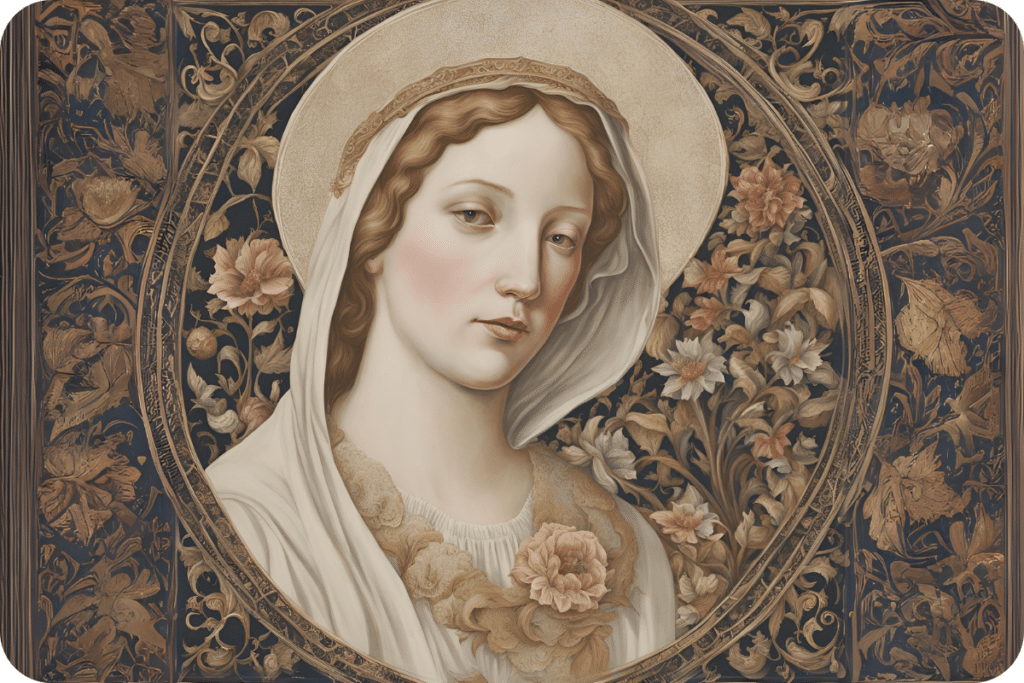
These artworks reflect her significance in salvation history and inspire devotion among the faithful. Iconography associated with Mary, such as lilies and crowns, further emphasizes her virtues. Through these artistic representations, Mary continues to inspire and nurture the spiritual lives of believers across cultures and generations.
Influence on Literature and Music
Mary’s story has profoundly influenced literature and music, inspiring countless hymns, poems, and stories that celebrate her life and virtues. Her song, the Magnificat, reflects her faith and humility, serving as a model for artistic expression.
Throughout history, writers and composers have drawn on her example, creating works that highlight her role in salvation history. From medieval poetry to contemporary music, these artistic expressions foster devotion and deepen the understanding of Mary’s significance, illustrating her enduring impact on Christian spirituality and culture.
Conclusion
Mary’s life, marked by faith, obedience, and love, serves as a beacon for Christians worldwide. Her journey, from humble beginnings to her veneration as Theotokos, illustrates the profound impact one life can have on history.
By accepting God’s call with grace, she played a pivotal role in the Incarnation, guiding believers in their spiritual journeys. Mary’s legacy continues to inspire devotion and trust in God’s plan, reminding the faithful of the transformative power of love and obedience in their own lives.
Reference
FAQ’s
1. Who was Mary in the Bible?
Mary, the mother of Jesus, is a central figure in Christianity, known for her faith, obedience, and role in the life of Jesus.
2. Why is Mary important in Christianity?
Mary is important for her role as the mother of Jesus, her unwavering faith, and her presence in key events of Jesus’s life and early Christianity.
3. What are the key events in Mary’s life according to the Bible?
Key events include the Annunciation, the birth of Jesus, the Wedding at Cana, witnessing the Crucifixion, and her presence at Pentecost.
4. How is Mary depicted in Christian art?
Mary is often depicted in scenes such as the Annunciation, Nativity, and Crucifixion, symbolizing her purity, motherhood, and sorrow.
5. What is the theological significance of Mary?
Mary’s theological significance includes her titles as Theotokos and her perpetual virginity, emphasizing her unique role in the Incarnation and salvation history.

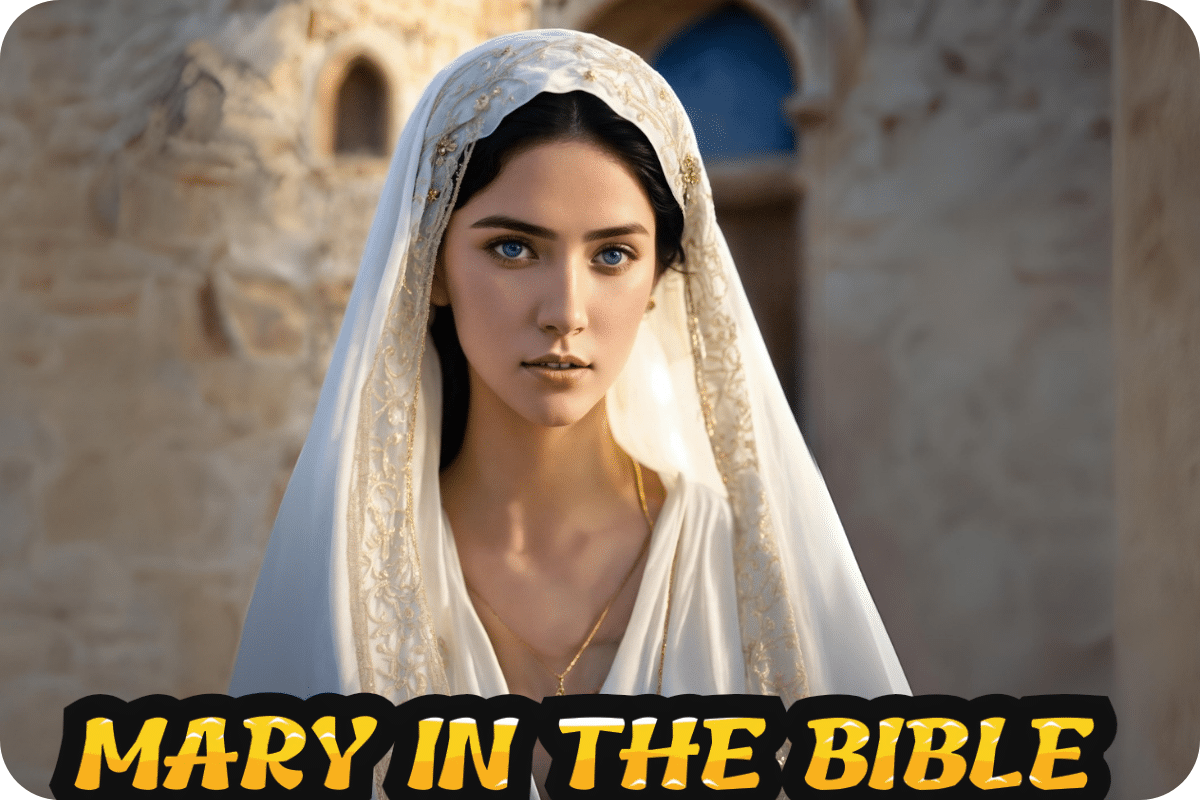
1 thought on “1. MERCIFUL MARY IN THE BIBLE”